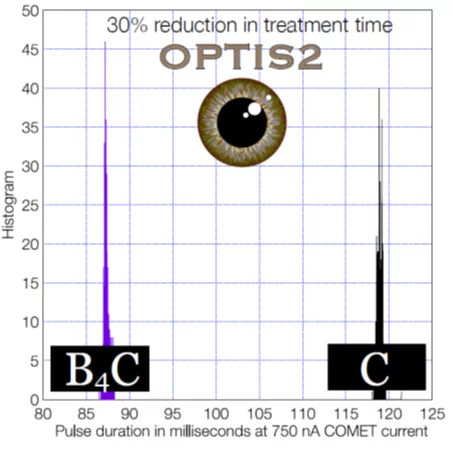At PSI’s Center for Proton Therapy (CPT), protons are used to treat cancerous tumours in a highly targeted way that spares healthy tissue as much as possible. This is the result of the characteristic way in which charged particles interact with matter, so that a beam of protons deposits most of its energy at a certain depth in a material depending on the energy and the composition of the material. The dedicated medical cyclotron COMET accelerates protons to an energy of 250 MeV, which then have to be "slowed down" so that the energy matches the depth of the tumour to be treated.
This is achieved with a so-called degrader in the beam, the thickness of which can be varied. The thicker the material, the more energy the protons lose, but at the cost of increased scattering which reduces the number of protons available for treatment. Any loss of protons for the patient increases the treatment time, which is of particular concern at OPTIS2, the ocular tumour treatment facility. Patients have to keep their gaze fixed on a specific point in space for the duration of the treatment.
Until recently, the material used in the degrader was graphite. Boron carbide (B4C) has a lower atomic mass and a higher density and is therefore expected to produce less scattering for the same energy reduction [1]. Initial beam tests in 2015 with a simple block of boron carbide and simulations confirmed a possible transmission improvement of around 37% over graphite. The resulting paper [2] on simulations and initial test measurements was well received by the scientific community with over 1200 downloads!
Boron carbide is one of the hardest materials known, which makes machining a challenge. Advances in manufacturing techniques have made it possible to produce the types of shapes (see Figure 1) in the quality required for particle therapy. However, the staff maintaining and operating the proton accelerator COMET had to overcome a number of manufacturing and design challenges to achieve the dimensional accuracy and quality required for clinical use at CPT.
The Computer Tomography (CT) equipment at CPT, normally used to image patients, was used to scan the wedges in order to check for internal defects such as cavities. At least one defective piece was identified this way, and discarded. The wedges were then heat-treated to relieve any residual stress that cause them to crack. Heating and cooling tests were also carried out to find the optimal cooling process to ensure sufficient cooling of the wedges during operation.
The final version of the B4C degrader was made clinically productive in June 2023. To ensure the high-quality standard of the treatments, extensive and time-consuming quality assurance measurements were carried out by CPT staff. A software tool [3] developed at PSI, which automatically determines the energy calibration for a given setting, made it possible to complete all the tests in the tight time window that was available.
Since then, the B4C degrader has been in continuous use for clinical operations at the CPT. The improvement in transmission confirms the results of the paper. The effective irradiation times at OPTIS2 were reduced by more than 30 % (see Figure 2).
Markus Kostezer, Andreas Mülhaupt, Christian Baumgarten, Daniela Kiselev (GFA), Zema Chowdhuri (ZPT)
References:
[1] F. Farley, Optimum strategy for energy degraders and ionization cooling, Nuc. Instr. Meth. A540 (2005) 235-244.
[2] A. Gerbershagen, C. Baumgarten, D. Kiselev, R. van der Meer, Y. Risters and M. Schippers, Measurements and simulations of boron carbide as degrader material for proton therapy, Phys. Med. Biol. 61 (2016) N337–N348
[3] R. Doelling, Automatisierte Ermittlung der Ortskurve des Degraders mit ATM. Interner Report P24/DR84-1720.0


